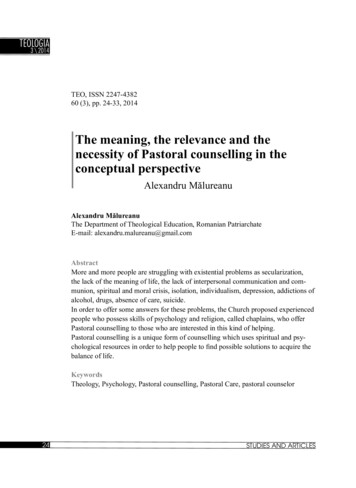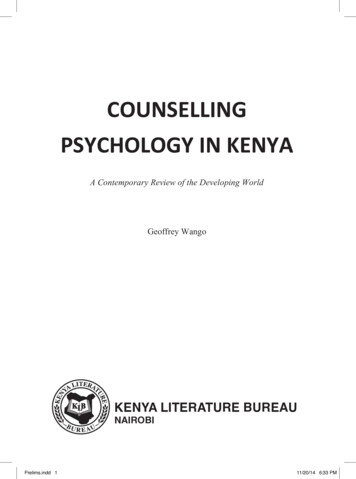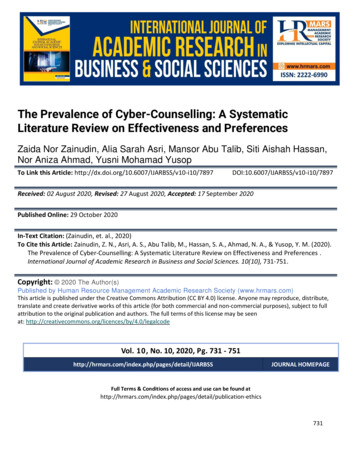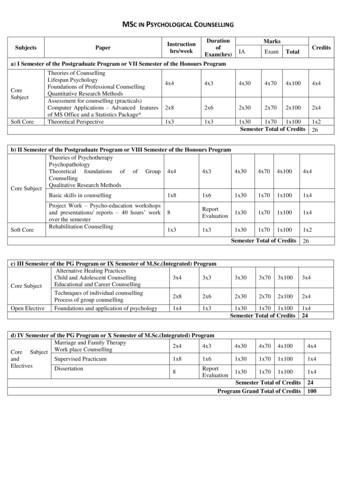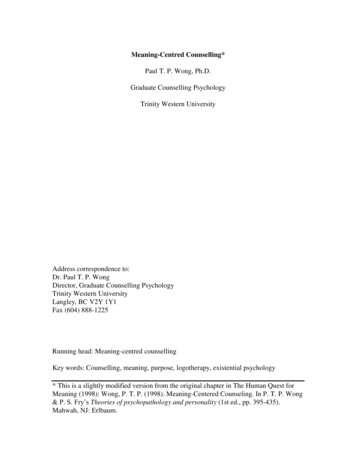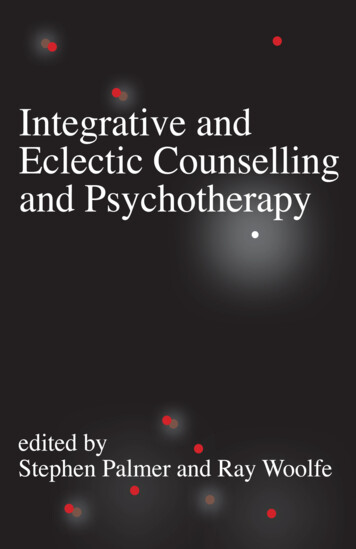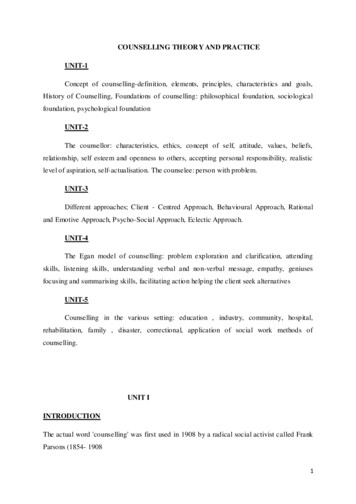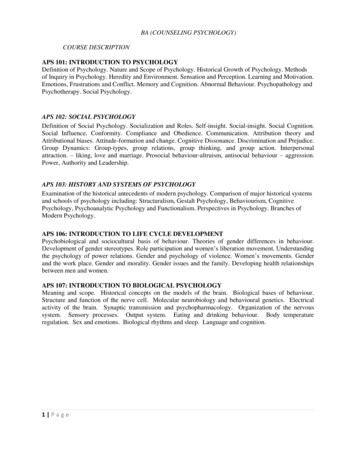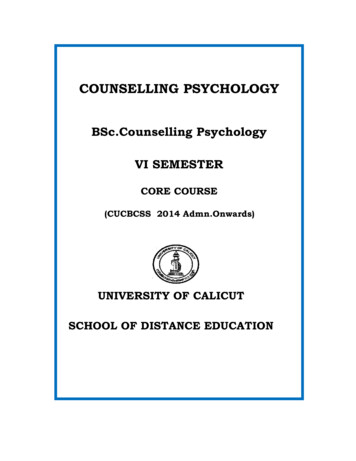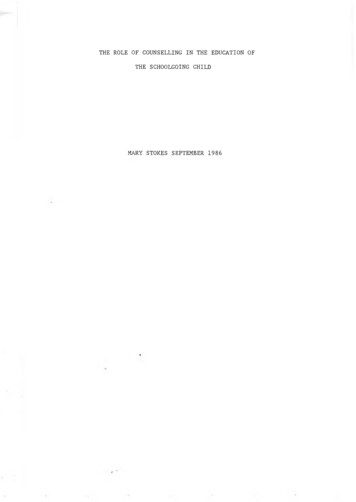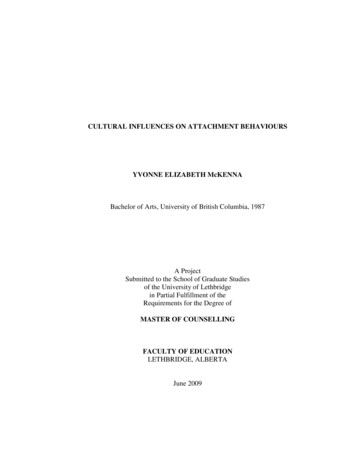
Transcription
CULTURAL INFLUENCES ON ATTACHMENT BEHAVIOURSYVONNE ELIZABETH McKENNABachelor of Arts, University of British Columbia, 1987A ProjectSubmitted to the School of Graduate Studiesof the University of Lethbridgein Partial Fulfillment of theRequirements for the Degree ofMASTER OF COUNSELLINGFACULTY OF EDUCATIONLETHBRIDGE, ALBERTAJune 2009
DedicationThis project would not have been completed without the support of my family. Therefore,I dedicate this to my parents who inspire me with their lifelong learning, to my sons whoremind me to enjoy and treasure every day, and to my husband whose love and supporthas helped me through all of this work. Thank you to all of you.iii
AbstractIn attachment research, there has been some debate about whether the hypotheses ofattachment theory concerning infant secure-base behavior, maternal sensitivity and thefuture competence of secure and insecure infants are culturally accurate (Carlson &Harwood, 2003; Harwood, 2006; Rothbaum, Weisz, Pott, Miyake, & Morelli, 2000).Proponents of attachment theory claim that maternal care that is sensitive and responsiveto the needs of the infant promotes secure-base (i.e., proximity-seeking or exploratory)behaviors resulting in secure parent-infant attachment and lifelong benefits (Carlson &Harwood; Rothbaum et al.). However, culturally appropriate parent and infant behaviorsin different ethnic contexts may not correspond to these hypotheses that are based onEuro-Western principles and assessments. In addition, classifications of attachment typesmay not describe or represent the distributions of secure or insecure infants in allcontexts. It was concluded through a literature review of 20 published studies (1988 to2008) that attachment theory is essentially universal with culturally specific expressionsof infant and maternal behaviors related to specific societal values and beliefs. Moreresearch is needed to determine the validity of the attachment hypotheses in diversecultures.iv
Table of ContentsDedication . iiiAbstract .ivTable of Contents .vList of Tables . viiiList of Figures .ixCULTURAL INFLUENCES ON ATTACHMENT BEHAVIOURS . 1Chapter I: Introduction . 1The Debate Over Attachment Theory and Culture . 2Project Value . 5Chapter II: Theoretical Foundations . 7Attachment Theory . 7Attachment Theory Hypotheses . 9Universality versus cultural specificity. 10Secure-base behavior hypothesis . 14Maternal sensitivity hypothesis. 16Future competence hypothesis . 17Cross-cultural Attachment Research. 20Attachment Assessments .20The Strange Situation Procedure .21The Attachment Q-sort . 23Defining Culture . 26Relevant Paradigms for Attachment Research . 27v
Chapter III: Procedures . 31Chapter IV: Literature Review of 20 Attachment Studies . 34Group Characteristics Comparisons .34Country-of-origin Status .35Socio-economic Status .36Secure attachment among middle- and low-income groups37Insecure attachment among middle-income groups .39Insecure attachment among low-income groups. 41Attachment Hypotheses in Cross-cultural Studies . 43Infant Secure-base Behavior . 43Type B (secure) infant attachment . 44Type A (insecure-avoidant) attachment . 50Type C (Insecure-ambivalent/resistant) attachment . 54Type D (insecure-disorganized) attachment . 60Maternal Sensitivity . 63Maternal control . 63Future Competence . 67Self-expression and social interaction . 68Autonomy and independence .69Universality Versus Cultural Specificity . 70Attachment Assessments . 71Limitations . 73Summary . 75vi
Chapter V: Implications for Attachment Research, Training and Intervention . 78Attachment Research Recommendations . 78Attachment Training and Intervention in Infant Mental Health . 80Conclusion . 82References . 84Appendices . .104A: Twenty Cross-cultural Attachment Studies: 1988 to 2008 . . .104B: Tables of Attachment Ratings for Ethnic Groupings of Samples . . 106C: Tables of Attachment Ratings for Socio-economic Groupings of Samples . .110D: Descriptions of Infant Attachment Classifications . . .114vii
List of TablesTable A: Twenty cross-cultural attachment studies: 1988 – 2008 . . .104Table B1: Euro-Western, middle-class attachment studies . .106Table B2: African-American attachment studies . . 107Table B3: Latino-American attachment studies . .107Table B4: North-American immigrant attachment studies . . .108Table B5: Latino attachment studies . 108Table B6: Asian attachment studies . .109Table B7: African attachment studies . .109Table C1: Comparison of attachment classification rates according to socio-economicstatus . 110Table C2: Accepted normative attachment rates . .113viii
List of FiguresFigure 1: Comparison distributions of attachment types in middle-incomesamples . .40Figure 2: Comparison of distributions of attachment types for low-income samplesassessed using the ABC Method (Ainsworth et al., 1978) 41Figure 3: Comparison of distributions of attachment types for low-income samplesassessed using the ABCD method (Main & Solomon, 1990) 42ix
1CULTURAL INFLUENCES ON ATTACHMENT BEHAVIOURSChapter I: IntroductionAttachment theory proposes a healthy relationship that occurs between a primarycaregiver (usually the mother) and an infant can result in a secure and safe haven for theinfant, thereby forming a close bond between the parent and child (Ainsworth & Bell,1970; Bowlby, 1969, 1988; Stayton, Ainsworth, & Main, 1973). Primary caregivers andinfants in all cultures engage in behaviors related to attachment, but there is considerabledebate as to whether classical attachment theory—based largely on research in EuroWestern populations (e.g., Caucasian Americans and Europeans with Western Europeanancestry)—is reflected consistently in all cultures (Cains & Combs-Orme, 2005; Carlson& Harwood, 2003, Crittenden, 2000; Rothbaum, Rosen, Ujiie, & Uchida, 2002;Rothbaum, Weisz, Pott, Miyake & Morelli, 2000).To assess whether the main hypotheses of attachment theory adequately reflectattachment behaviors in all cultures, this final project presented a literature review thatattempted to answer the following four questions:1. How are the hypotheses of attachment theory addressed in cross-culturalattachment research and do they adequately and universally predict secure and insecureinfant attachment in the studies reviewed?2. Are the assessments used in attachment research valid in all cultures?3. Are the descriptions of infant and care-giving behaviors related to secure andinsecure attachment patterns similar across diverse cultures?
24. What parenting practices related to secure parent-infant attachment arerecommended in attachment theory and are these practices culturally appropriate in allcontexts?This final project reviewed 20 cross-cultural attachment research studies carried out inEuro-Western and non-Western contexts over the past 20 years that focused on how thehypotheses of attachment theory regarding universality, infant secure-base behavior,maternal sensitivity and future developmental competence (i.e., infant cognitive andsocial-emotional development) are represented in diverse cultures. The primary objectiveof this final project was to identify the similarities and differences between the accepteddescriptions of infant and caregiver behaviors in the classical attachment theory and thedescriptions found in studies of diverse cultures in cross-cultural attachment research.This comparison was used to provide evidence that attachment theory is not universallymanifested in all contexts and highlights the need for practitioners to take a broader viewof attachment until more culturally sensitive research is available.The Debate Over Attachment Theory and CultureAttachment research primarily involves the assessment of mother-infantattachment bonds using two methods: the Strange Situation Procedure (SSP) devised byAinsworth (Ainsworth & Bell, 1970; Ainsworth, Blehar, Waters, & Wall, 1978; Staytonet al., 1973) and the Attachment Q-sort (AQS) (Vaughn & Waters, 1990; Waters &Deane, 1985). Early North American attachment studies of these assessments andsubsequent meta-analyses from other countries (Ainsworth et al.; Main & Solomon,1990; van IJzendoorn & Kroonenberg, 1988; van IJzendoorn & Sagi, 1999; vanIJzendoorn, Vereijken, Bakermans-Kranenburg, & Riksen-Walraven, 2004; Vaughn &
3Waters; Waters & Deane) have resulted in established security rates that manyattachment researchers consider as normative measures or global standards (Posada, Gao,Wu, Posada, Tascon, Schoelmerich, et al., 1995; van IJzendoorn & Kroonenberg; vanIJzendoorn & Sagi; Vaughn, Strayer, Jacques, Trudel, & Seifer, 1991). However, crosscultural research on attachment over the past few decades has shown variations ofsecurity rates in different ethnic cultural contexts (Bakermans-Kranenburg, vanIJzendoorn, & Kroonenberg, 2004; Mizuta, Zahn-Waxler, Cole, & Hiruma, 1996; Sagi,Lamb, Lewkowicz, Shoham, Dvir, & Estes, 1985; Sagi, van IJzendoorn, Aviezer,Donnell, et al., 1995; Sagi, van IJzendoorn, & Koren-Karie, 1991).Secure infant attachment is consistently found to be the most prevalent attachmentpattern in environments with few risk factors (e.g., poverty, low maternal age andeducation level, family conflict, maternal psychopathology) affecting the parent-infantrelationship and is considered the preferred type of attachment since it is associated withpositive socio-emotional and developmental outcomes (Ainsworth et al., 1978;Crittenden, 2000; Porges, 2003; Schore, 2001; van IJzendoorn & Kroonenberg, 1988).Insecure attachment typically occurs in the parent-infant relationship when the presenceof risk factors promotes caregiver behaviors of insensitivity and poor responsiveness tothe infant’s cues, which results in the infant developing maladaptive behaviors that limitthe development of secure attachment (Ainsworth et al.; Belsky & Fearon, 2002; Bowlby,1988; Crittenden). However, studies of diverse populations that differ from those in theoriginal attachment studies (Ainsworth et al.; Main & Solomon, 1990; Waters & Deane,1985) have shown variations in the distributions of insecure attachment rates, which may
4indicate positively adaptive maternal and infant behaviors in that context (Carlson &Harwood, 2003; Harwood, 2006; Rothbaum et al., 2000).The universality hypothesis of attachment theory suggests that attachmentsecurity patterns are consistent across all cultures with the secure type being the superior,preferred type of attachment and insecure types being the deviant or non-preferred typesthat occur in the presence of multiple risk factors in the environment (Bowlby, 1969,1988; van IJzendoorn & Kroonenberg, 1988; van IJzendoorn & Sagi, 1999, 2001).Conversely, some researchers who propose a more culturally sensitive version ofattachment theory suggest that some insecure attachment behaviors may be positivelyadaptive responses to specific contextual and cultural antecedents in the same way thatsecure attachment behaviors are contextually adaptive (Crittenden, 2000; Rothbaum etal., 2000; Posada et al., 2004; True, Pisani, & Oumar, 2001). Both views emphasize theimportance of sensitive care from the primary caregiver and the existence of specificinfant secure-base (i.e., exploratory and proximity-seeking) behaviors, but disagree as tohow these behaviors are measured and interpreted in relation to culture.Kuhn (1970), in his discussion of the nature of scientific paradigms and theirchanges, highlighted the importance of considering counter-argument examples wheninvestigating and understanding a theory. Researchers who defend the universality ofattachment theory and those who question its validity in all societies point to examplesthat emphasize their opposing views. These counter-argument examples are the basis forinvestigation in this project.
5Project ValueIn addition to highlighting the need for a closer look at how attachmentrelationships are assessed in diverse cultures, this project is valuable for several reasons.First, this topic is relevant to infant mental health professionals working with parents andcaregivers of infants who want to know what care-giving and infant behaviors to supportand encourage in diverse cultural contexts (Brynelsen, 2007; Greenspan, 1992; InfantMental Health Promotion Project [IMP], 2002; Zeanah, Larrieu, & Zeanah Jr., 2000).These professionals provide programs (e.g., counseling, family support, parent education,childcare) for families with children under the age of three from many cultures andcontexts, and promote care-giving practices that encourage positive parent-infantrelationships (Barrera & Corso, 2003; Brynelsen; Garcia Coll & Meyer, 1993; Gilkerson& Stott, 2000; IMP; Ontai, Mastergeorge, & Families with Young Children Workgroup,n.d; Recchia & Williams, 2006; Shirilla & Weatherston, 2001).Second, this literature review addresses the ethical importance for counselors toadopt a culturally inclusive set of attitudes, knowledge and skills when promotingculturally appropriate attachment-based parenting behaviors (i.e., best practices) inresearch and intervention (Arthur & Collins, 2005; Bowlby, 1988; Gilkerson & Stott,2000; Greenspan, 1992; Zeanah et al., 2000). It is essential that infant mental healthprofessionals provide culturally sensitive services by learning how different care-givingpractices fit into the cultural contexts that they work in (Barrera & Corso, 2003; Shirilla& Weatherston, 2001). Promoting practices based on one culture (usually the EuroWestern culture) may lead to under- or over-referrals based on diagnoses of insecureattachment (British Columbia Ministry of Children and Family Development [BC
6MCFD], 2003; Restoule, 1997). Unless certain cultural issues are better understood,infant mental health professionals in Canada risk under-serving populations that havedifferent cultural backgrounds (BC MCFD), over-identifying parents as having poorattachment relationships with their children (Restoule), falsely referring families forintervention for insecure attachment and/or castigating them for their cultural beliefs andpractices (Berg, 2003; Melendez, 2005; Rameka, 2003; Yeo, 2003).Finally, this literature review of published studies is valuable because it representsan in-depth investigation of cross-cultural attachment research that focused on all of theavailable peer-reviewed studies and not only studies that supported one or anotherviewpoint. This criterion has not been applied to similar reviews of this subject (vanIJzendoorn & Kroonenberg, 1988; Crittenden, 2000; Rothbaum et al., 2000).The remainder of this report is structured as follows: Chapter II provides adiscussion of theoretical foundations of cross-cultural attachment research; Chapter IIIdescribes the procedures used in this final project; Chapter IV provides a review of 20studies according to the populations represented and the four attachment hypotheses; andChapter V presents a discussion of the implications on attachment research, thelimitations of this project and recommendations for future research and intervention.
7Chapter II: Theoretical FoundationsThis study investigates cross-cultural research in attachment to determine whetherthe original hypotheses of attachment theory have been adequately defined and applied todiverse populations. This chapter describes attachment theory, attachment assessmentmethods, and the literature on cross-cultural attachment research. Since this final projectis based on attachment theory in different parenting cultures, it is important to understandhow attachment theory is adapted from different theories, ethological evidence andempirical research and how cultural similarities and differences are represented.Attachment TheoryBased on his work as a pediatrician and as a psychoanalyst, Bowlby (1969)developed attachment theory from psychoanalytic and ethological bases. Ainsworth(Ainsworth, 1961, 1967; Ainsworth et al., 1978; Ainsworth & Bowlby, 1991; Bretherton& Main, 2000) completed field research in Uganda and the United States, and developedmethodology and classification systems based on attachment theory. Modern attachmenttheory is based on these foundations established by Bowlby (1969, 1988) and Ainsworth(Ainsworth, 1961, 1967; Ainsworth et al.; Ainsworth & Bowlby).Bowlby (1969, 1988) described attachment as the essential relationship that keepsthe primary caregiver in close proximity to the infant and, conversely, the infant seekingthe attention of the caregiver when he or she is feeling distressed. He stated, “The child’sattachment behavior is activated especially by pain, fatigue, and anything frightening, andalso by the mother being or appearing to be inaccessible” (Bowlby, 1988, p. 3). Once theattachment system is activated, the infant seeks out the caregiver or signals the caregiverthat comfort or protection is needed. Bowlby (1988) focused on the “function and
8organization of emotional bonds” (p. 162) between parent and infant for the purpose ofprotection and comfort of the infant (George & Solomon, 1999; Main, 1999; Porges,2003, 2007; Schore, 2003b). The regulating mechanism of secure attachment ensures theinfant is comforted and returned to pre-stressed levels quickly so that importantexploration and learning can occur (Porges, 2003, 2007). Attachment security that aninfant develops with his or her primary attachment figure depends on the type of care thatthe infant receives and influences future childhood and adulthood interpersonalrelationships (Hamilton, 2000; Lewis, Fiering, & Rosenthal, 2000; Main; Waters,Hamilton, & Weinfield, 2000; Weinfield, Whaley, & Egeland, 2004), and cognitive,social and emotional growth in childhood and adulthood (Belsky & Fearon, 2002;Porges; Schore).As Bowlby’s student (Ainsworth, 1967, Ainsworth & Bowlby, 1991; Bretherton& Main, 2000), Ainsworth studied mother-infant dyads beginning in 1954 in Uganda andin 1961 in Baltimore. In her extensive field research, Ainsworth (1961, 1967, Ainsworthet al.) investigated how attachment develops, what factors facilitate or delay thisdevelopment, and what the criteria were for determining whether attachment hasformed—questions that are still being looked at today. She identified the concepts ofsecure and insecure infant attachment, and maternal sensitivity through observations ofinfant secure-base behaviors and maternal behaviors in home observations and in herStrange Situation Procedure (SSP) involving repeated separations and reunions betweenmother and infant (Ainsworth & Bell, 1970; Ainsworth et al.). The infant secure-basebehaviors included proximity-seeking (e.g., crawling and walking towards, wanting to beheld) and proximity-enhancing behaviors (e.g., crying, reaching out, snuggling) towards
9caregivers. Caregiver behaviors associated with the infants’ secure or insecure behaviorsincluded indications of sensitivity and responsiveness to infants’ signals.Conducting research in Uganda, Ainsworth (1961, 1967) identified three patternsof attachment behavior in infants according to the strength and quality of the relationshipto their mothers: secure, insecure and non-attached. She concluded that secure attachmentrequired “much physical contact, much interaction between the infant and his mother,much social stimulation, prompt gratification of creature-comfort, lack of confinement,and freedom to explore the world” (Ainsworth, 1967, p. 330). Later, the category of nonattached was omitted and insecure attachment was separated into insecure-avoidant andinsecure-resistant/ambivalent attachment. These classifications are still used today andknown as Type B (secure), Type A (insecure-avoidant) and Type C (insecureambivalent/resistant) (Ainsworth et al., 1978; Main & Solomon, 1990). In addition tothese attachment types, Main and Solomon described a fourth category of Type D(insecure-disorganized) attachment, which is associated with an infant’s disorganizationof adaptive strategies to seek comfort and security as a result of care by primarycaregivers who portray frightened or frightening behaviors towards their infants due tothe caregiver’s experience of unresolved loss or trauma.Attachment Theory HypothesesFour general hypotheses of attachment theory have been recognized in research(Rothbaum et al., 2000; van IJzendoorn & Sagi, 1999): the universality hypothesis, theinfant secure-base behavior hypothesis, the maternal sensitivity hypothesis, and the future(developmental and social) competence hypothesis.
10Universality versus cultural specificity. There are three basic assumptionsregarding universality in attachment. First, it is assumed all infants form attachments(secure or insecure) to their primary caregivers, even in the presence of developmentaldelays (Benoit, Madigan, Lecce, Shea, & Goldberg, 2001; Rutgers, van IJzendoorn,Bakermans-Kranenburg, & Swinkels, 2007), autism (Rutgers et al.), neglect or abuse(Lyons-Ruth & Jacobvitz, 1999), or parental psychopathology (Bradley, 2000; Bowlby,1988; Diego, Field, & Hernandex-Reif, 2005; Hossain, Field, Gonzales, Malphurs, & DelValle, 1994; Schore, 2003a). Therefore, this hypothesis is generally accepted as proven.The second assumption is that there are predictable or universal antecedents andconsequences for secure parent-infant attachment (Crittenden, 2000; Rothbaum et al.,2000). This assumption relates to two other attachment hypotheses, maternal sensitivityand future competence, which are discussed later in detail. There is debate about whatcontexts are necessary antecedents for secure infant attachment to form (Crittenden; DeWolff & van IJzendoorn, 1997; Rothbaum et al.) and what constitutes competence inlater development. Even though attachment research has identified environmental factorsand future effects that correlate with secure and insecure attachment, there is noconsensus on which factors are the most important and how they correlate with thedistributions of attachment classifications in different cultures (Crittenden, 2000; DeWolff & van IJzendoorn; Rothbaum et al.).The third assumption of the universality hypothesis is that there is a predictable‘global’ or ‘standard’ distribution of secure and insecure attachments (BakermansKranenburg et al., 2004; Main, 1999). This assumption is one of the most contestedaspects of the cross-cultural attachment debate (Chao, 2001; Claussen & Crittenden,
112000; Crittenden, 2000; Gjerde, 2001; Harwood, Schoelmerich, & Schulze, 2000;Kondo-Ikemura, 2001; Posada & Jacobs, 2001; Rothbaum et al., 2000, 2001; Rothbaum,Kakinuma, Nagaoka, & Azuma, 2007; van IJzendoorn & Sagi, 1999, 2001). BakermansKranenburg et al. defined the two camps in this debate: those that believe that there areno between-group differences in the development of attachment when influencing riskfactors are considered (e.g., low-income, poverty effects, stressful environments), andthose who believe differences between groups are related to risk factors and “adaptiveresponses to the demands of the cultural environment” (p. 419). Difficulty in definingculture and concerns regarding measurement bias are addressed below.The assumed global or standard distribution of the four attachment classificationsis based on Ainsworth et al.’s (1978) original SSP studies and attachment classifications,and is generally measured as 67% Type B (secure), 21% Type A (insecure-avoidant), and12% Type C (insecure-resistant/ambivalent). When the disorganized category was added(Main & Solomon, 1990), the accepted rates became approximately 63% Type B(secure), 14% Type A (insecure-avoidant), 9% Type C (insecure-ambivalent/resistant)and 14% Type D (insecure-disorganized) (Main & Solomon, 1990; van IJzendoorn et al.,1999). Meta-analyses of attachment studies in several different countries, conducted byvan IJzendoorn and colleagues (van IJzendoorn & Kroonenberg, 1988; van IJzendoorn etal.), reported global evidence for these patterns of attachment types when the sampleswere combined, though they indicate variations from these distributions among thesamples. They also found that there were as many within- as between-country differencesin the distributions of attachment types (van IJzendoorn & Kroonenberg). These resultswere believed to reflect the universal view that the attachment distribution rates in Euro-
12Western (European and North American), middle-class families (a heterogeneous group)is the ideal to which other samples’ distributions should be compared (Behrens, Hesse, &Main, 2007; van IJzendoorn & Sagi, 1999; Vaughn et al., 1991). The divergent findingsin non-Western populations were attributed to unidentified methodological problems orrisk factors that may have influenced the results. This justification, however, did notexplain the samples in van IJzendoorn and Kroonenberg’s 1988 study in which higherrates of secure attachment than averages of the Euro-Western were found in thesecombined studies. Risk and protective factors are believed to influence attachmentdistribution rates that differ from the Euro-Western rates, but these are poorly understood(Bakermans-Kranenburg, van IJzendoorn, & Juffer, 2005; Belsky, 2002; Main, 1999). Inshort, researchers have assumed a universal distribution of four types of behavior, but theevidence to support this assumption appears to be invalid.Risk factors and protective factors influence the environment and care in whichthe infant is raised (Axe, 2007; National Institute of Child Health and HumanDevelopment [NICHD], 2006; Schore, 2003a, 2003b). Risk factors impede thedevelopment of secure attachment between infants and their primary caregivers. Theserisk factors can include innate factors of the infant (e.g. difficult temperament, regulatoryproblems, prematurity, low birth weight) (Porges, 2003; Schore 2001, 2003a, 2003b), butthey mainly include environmental risk factors (e.g. family dysfunction, poverty,adolescent parent, poor quality of child care, undesirable neighbourhood location) andcare-giving factors (maternal depression, poor maternal prenatal health, negative parentalattitude, parental psychopathology and inconsistency of parenting) (Axe, Belsky &Fearon, 2002; Human Resources Development Canada, 1996; NICHD; Porges, 2003;
13Schore, 2001). Belsky and Fearon (2002) also identified ethnic minority status as a riskfactor for the development of insecure attachment due to the connection of poverty withminority status in the United States (NICHD), but Barrera and Corso (2003) cautionedthat ethnicity is not something that should be targeted to be changed or improved, as withother risk factors.Protective factors are those that increase the chance of an infant developinghealthy social and emotional attachment with a primary caregiver and promote thedevelopment of resilience and coping strategies that help to ameliorate the effects of riskfactors (Br
Bachelor of Arts, University of British Columbia, 1987 . A Project . Submitted to the School of Graduate Studies . of the University of Lethbridge . in Partial Fulfillment of the . Requirements for the Degree of . MASTER OF COUNSELLING . FACULTY OF EDUCATION . LETHBRIDGE, ALBERTA . June 2009

